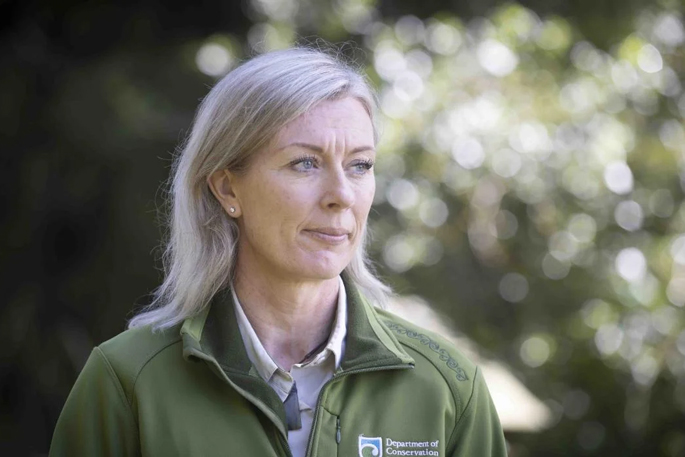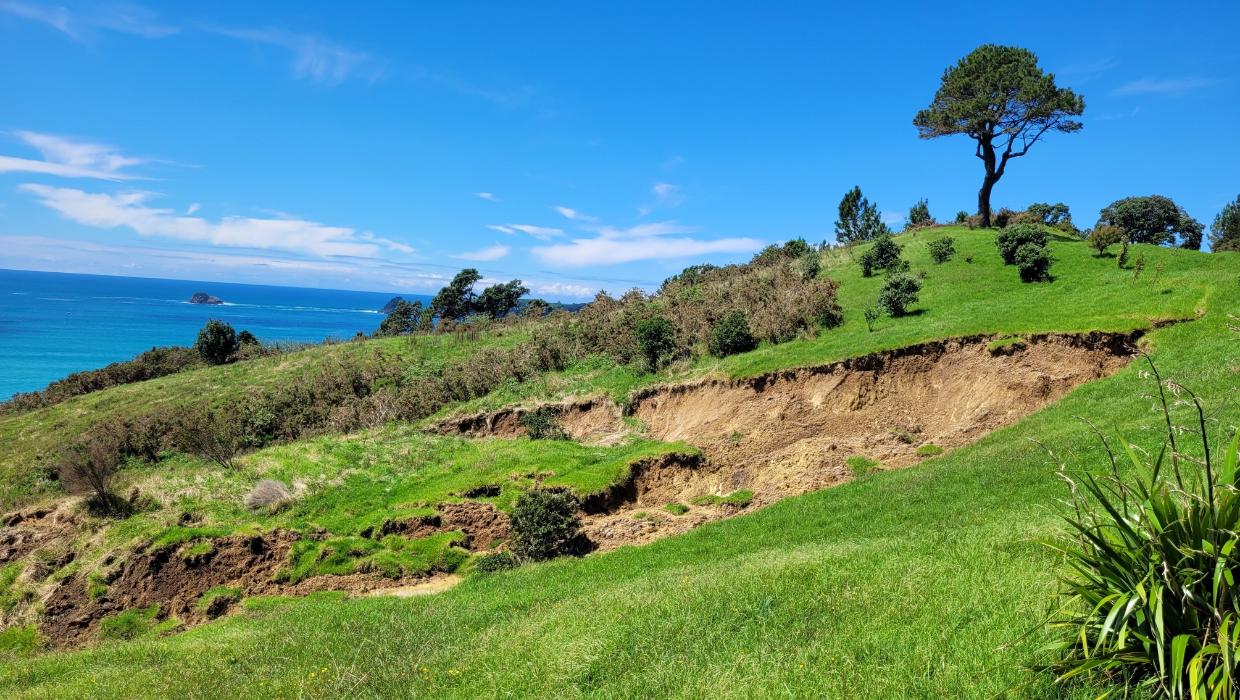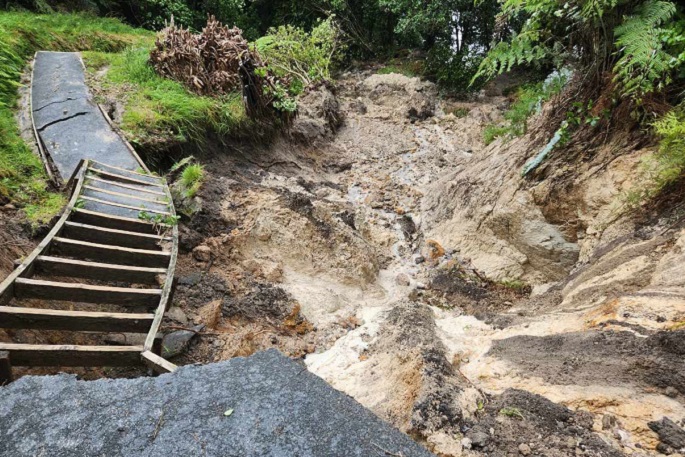As the anniversary of the Cathedral Cove walking track closure draws near, Coromandel locals say their frustrations are reaching new heights.
Those feelings are exacerbated by the fact “track closed” signs have been ignored by hundreds of people per day over the main summer holiday period, and that any hopes of the track being opened this summer have been dashed by a Department of Conversation announcement last week.
DOC plans to commission a further six months of land stability monitoring and says it will consult with local iwi on a number of options, which will then be shared in September.
Mercury Bay Business Association spokesman Ray Van Beynen says DOC should also afford local communities and businesses the courtesy of consultation alongside local iwi.
“Being given options after effectively 18 months of inaction and virtually no consultation is disgraceful,” says Ray, who believes the discussion timeframe effectively keeps the Cathedral Cove track closed for another summer season.
“Furthermore, DOC could, and should, have continued Geotech monitoring over the past 11 months and appear unable to explain why that did not occur.”
He says the sentiment amongst the majority of locals is DOC should spend the required money to mend what’s needed and then declare the track – and the Coromandel – open for business.
It's not too late, Ray says, to make an effective, safe short-term repair so the track can be enjoyed for the remainder of this summer.
“In the main it needs an informal detour to be formalised and a set of steps built for beach access. We estimate two weeks of work and around $100,000. That would make the track use-friendly and safe. Further repairs could be done later.
“Only one section of the track, covering solely some 50 metres, has been washed away. The other 90 per cent of the track is virtually unchanged,” says Ray.
 The Cathedral Cove walking track has been fenced off. Supplied photo.
The Cathedral Cove walking track has been fenced off. Supplied photo.
But DOC’s Hauraki-Waikato-Taranaki regional director Tinaka Mearns says, in her recently-released press release, that short-term solutions are not viable.
What DOC will be doing is working alongside local iwi, Ngāti Hei, from February to April to develop options and conceptual ideas, which will then be shared for wider public engagement. The land stability monitoring results are expected in June 2024.
It is vital, she says, for DOC to have “a robust, detailed and properly resourced plan” for the site, to ensure visitors ultimately have a safe and enjoyable experience.
“Our goal is to reopen the track – but it must be done safely and in a durable and pragmatic way that lasts.”
Hahei General Store owner Shane Wakefield is one businessman hopeful the re-opening of the track isn’t delayed until late in the year.
Local business owners most often enjoy the benefits of international visitors over winter and the shoulder seasons, he explains.
Those numbers are significant, with the cove recorded as one of NZ’s most-visited tourist attractions, with upward of 300,000 people visiting per year (a pre-Covid figure).
Shane says business has been down at his store on the previous year for every month since the track closure, although January had been good due to beautiful weather compared to the rain of last January.
“Once the Kiwi holiday period is over at the end of Waitangi Weekend we expect things to drop”. There will be “no massive uplift” until the Cathedral Cove track re-opens, he says.
Ray says DOC should consider the role it is playing in costing the Coromandel Peninsula millions of dollars in documented economic loss after three consecutive years of dire economic circumstance.
One in five Coromandel Peninsula workers depend on tourism for their livelihood. After two difficult years with Covid and a third with severe weather events all locals want is a return to normal, he says.
During a recent radio interview with NZ Minister of Tourism and Hospitality Matt Doocey, Coromandel’s CFM reporter John Freer stated that closure of the track had cost businesses $100 million in one year since Cyclone Gabrielle struck NZ in February 12.
Ray believes DOC’s behaviour has been “inexplicable” from the very beginning. DOC states its decision to close the track was based on expert scientific advice following the commissioning of a Tonkin Taylor geotechnical report. But Ray points out that report offers a number of viable options to safely repair and reopen the track – all ignored by DOC.
“The very nature of the Coromandel Peninsula's geography and geology is of relatively unstable ground prone to slips after heavy rain. That has always been the case and in the past a sound repair job until the next event was perfectly acceptable. No amount of money is going to make it 100 per cent safe or 100 per cent resilient.
“That it has taken DOC nearly a year to come to this conclusion, and without any clear communications or consultation, is a slap in the face for local communities and key stakeholders,” Ray says.
Ray says while further monitoring by Tonkin Taylor is indeed crucial, it could have been done over the past year, thereby fast-forwarding repairs and a re-opening of the track.
He is also concerned that DOC is “suddenly floating the proposition that the track may now never reopen”.
DOC Hauraki-Waikato-Taranaki regional director Tinaka Mearns is hitting back at the claims made by Ray above.
 DOC’s Hauraki-Waikato-Taranaki regional director Tinaka Mearns. Kelly Hodel / Waikato Times.
DOC’s Hauraki-Waikato-Taranaki regional director Tinaka Mearns. Kelly Hodel / Waikato Times.
“We’ve consistently said the track is unsafe, and although some sections appear undamaged, there is landslide risk is across the wider site,” Tinaka says in a statement to SunLive.
“Since early 2023 we’ve said the track shouldn’t be used and we’re concerned people still ignore that advice.
“The most common visitor type to Cathedral Cove is a ‘day tripper’, 75 per cent of who are international tourists without the expertise or experience required for what is now an unsafe site.
“For us, safety is about managing to a level of risk aligned to the visitor type. No outdoor experience is ever safe, it’s about meeting people’s expectations of safety.
“At present we are above the acceptable risk level for the most frequent visitor group for Cathedral Cove, and so our next phase of work is finding a way to get inside the tolerable level with a view to reaching the goal of re-establishing walking access.
“Simply applying a short-term fix to the stairs and track is not viable and will not address long-term land stability and rock fall challenges at this site – challenges and risks DOC has been managing and publicised for more a long period of time.
 A geotechical report found about 180 historic and recent landslides in the hills above and around Cathedral Cove. Photo: DOC.
A geotechical report found about 180 historic and recent landslides in the hills above and around Cathedral Cove. Photo: DOC.
“Monitoring of the site is being undertaken by DOC staff, who’re taking photographs and notes about land movement and instability at the site – info they’re sharing directly with Tonkin + Taylor.
“Contrary to Mr van Beynen’s claims, we haven’t ‘ignored’ Tonkin + Taylor’s advice about viable options for track rerouting - we’re diligently working through those using a phased approach. We have taken this approach as our records tell us this is not new. In 2011 similar circumstances lead to track closure for 20 months, we want solutions to be resilient so they give the community and businesses that rely on outdoor experience improved sustainability..
“Part of that phased approach was developing this summer’s visitor experience, to support Coromandel’s tourism economy.
“Several media outlets have published several stories on how busy Coromandel is this summer, which we’re delight.
“We’re constantly engaging with iwi as part of our Conservation Act mandate, and we have been engaging with stakeholders– including the Mercury Bay Business Association – on this topic. We’ll have a visitor survey available in February.
“Engagement work continues and coincides with options development.
“We’ve been clear we’re working through a complex set of overlapping issues and our ambitious goal is to find a safe and resilient walk for visitors to access the beach.”



0 comments
Leave a Comment
You must be logged in to make a comment.